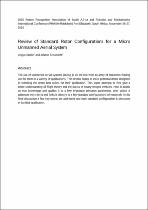JavaScript is disabled for your browser. Some features of this site may not work without it.
- ResearchSpace
- →
- Research Publications/Outputs
- →
- Conference Publications
- →
- View Item
| dc.contributor.author |
Steele, A

|
|
| dc.contributor.author |
Treurnicht, J

|
|
| dc.date.accessioned | 2016-10-03T12:51:48Z | |
| dc.date.available | 2016-10-03T12:51:48Z | |
| dc.date.issued | 2015-11 | |
| dc.identifier.citation | Steele, A. and Treurnicht, J. 2015. Review of standard rotor configurations for a micro unmanned aerial system. In: The 26th Annual Symposium of the Pattern Recognition Association of South Africa (PRASA) and The 8th Conference of Robotics and Mechatronics (RobMech) of South Africa, Port Elizabeth, South Africa on 26 and 27 November 2015 | en_US |
| dc.identifier.uri | http://ieeexplore.ieee.org/stamp/stamp.jsp?arnumber=7359510 | |
| dc.identifier.uri | http://hdl.handle.net/10204/8782 | |
| dc.description | The 26th Annual Symposium of the Pattern Recognition Association of South Africa (PRASA) and The 8th Conference of Robotics and Mechatronics (RobMech) of South Africa, Port Elizabeth, South Africa on 26 and 27 November 2015. Due to copyright restrictions, the attached PDF file only contains the abstract of the full text item. For access to the full text item, please consult the publisher's website | en_US |
| dc.description.abstract | The use of unmanned aerial systems (UAS) is on the rise with an array of industries finding use for them in a variety of applications. This review hopes to assist potential drone designers in selecting the drone best suited for their application. This paper attempts to first give a better understanding of flight theory and the basics of rotary winged vehicles. Next it builds on that knowledge and applies it to a few important selection parameters, after which it addresses the criteria and links it directly to a few standard configurations of rotorcraft. In the final discussion a few key points are addressed and each standard configuration is discussed in its ideal application. | en_US |
| dc.language.iso | en | en_US |
| dc.publisher | IEEE | en_US |
| dc.relation.ispartofseries | Workflow;16234 | |
| dc.subject | Standard rotor configurations | en_US |
| dc.subject | Micro unmanned aerial system | en_US |
| dc.subject | UAS | en_US |
| dc.subject | Rotor Theory | en_US |
| dc.subject | Thrust | en_US |
| dc.title | Review of standard rotor configurations for a micro unmanned aerial system | en_US |
| dc.type | Conference Presentation | en_US |
| dc.identifier.apacitation | Steele, A., & Treurnicht, J. (2015). Review of standard rotor configurations for a micro unmanned aerial system. IEEE. http://hdl.handle.net/10204/8782 | en_ZA |
| dc.identifier.chicagocitation | Steele, A, and J Treurnicht. "Review of standard rotor configurations for a micro unmanned aerial system." (2015): http://hdl.handle.net/10204/8782 | en_ZA |
| dc.identifier.vancouvercitation | Steele A, Treurnicht J, Review of standard rotor configurations for a micro unmanned aerial system; IEEE; 2015. http://hdl.handle.net/10204/8782 . | en_ZA |
| dc.identifier.ris | TY - Conference Presentation AU - Steele, A AU - Treurnicht, J AB - The use of unmanned aerial systems (UAS) is on the rise with an array of industries finding use for them in a variety of applications. This review hopes to assist potential drone designers in selecting the drone best suited for their application. This paper attempts to first give a better understanding of flight theory and the basics of rotary winged vehicles. Next it builds on that knowledge and applies it to a few important selection parameters, after which it addresses the criteria and links it directly to a few standard configurations of rotorcraft. In the final discussion a few key points are addressed and each standard configuration is discussed in its ideal application. DA - 2015-11 DB - ResearchSpace DP - CSIR KW - Standard rotor configurations KW - Micro unmanned aerial system KW - UAS KW - Rotor Theory KW - Thrust LK - https://researchspace.csir.co.za PY - 2015 T1 - Review of standard rotor configurations for a micro unmanned aerial system TI - Review of standard rotor configurations for a micro unmanned aerial system UR - http://hdl.handle.net/10204/8782 ER - | en_ZA |






